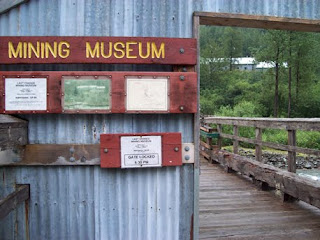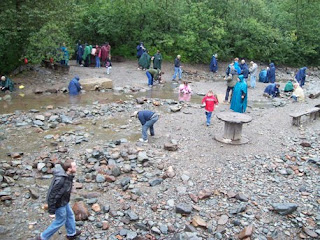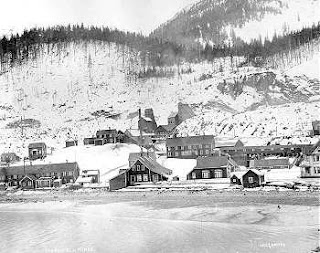The first creek to spotlight is the closest one to me at the moment. Gold Creek. I will be posting all my research as I go and will create a final report on each creek once I have exhausted my resources. Here is the online information I have found in a timeline format.
Gold Creek, Juneau, AK
1870 - The Gastineau Channel area was a fishing ground for native Tlingit and Haida people of Southeast Alaska for thousands of years; Tlingits are the most numerous in Juneau. In 1870, the largest permanent settlement in the Juneau area was Auk Village. What later became Douglas Island was Taku territory. Gold Creek was called Dzantik'i Heeni; Tlingits considered it the "biggest salmon creek of all."
1871 - The saloons, of which in 1871 there were already twenty-two, have increased proportionately, and there are, further, at least one weekly newspaper, one volunteer fire brigade, a militia company and a brass band in Juneau. The curio shops on Front and Seward streets are well worth visiting, and from the top of Seward Street a path leads up to the Auk village, whose people claim the flats at the mouth of Gold Creek.
1872 - The precious metal was originally discovered near Sitka in 1872. Eight years later, the state's first big gold strike made news in Juneau, when two prospectors and their Indian guide collected over 1000 pounds of gold ore in what is now aptly named Gold Creek.
1877 - Outline history of development and description of placer and vein deposits in area less than 200 mi east of Juneau, Alaska; known gold-bearing veins occur in volcanic rocks, in area 3 by 5 mi; some veins are 15 to 100 ft. wide; larger veins contain little pyrite or other sulphide and are not known to contain visible free gold; in 1877, McDame Creek produced nugget worth $1300.00.
1879 - Placer gold was found at the mouth of the creek in 1879 and the " city " was settled in the following year by two prospectors named Joseph Juneau and Richard Harris. The camp was called Harrisburg until it was given its present name of Juneau. The principal gold-mines are situated in the adjacent Silver Bow basin, the source of Gold Creek and the site of the Great Perseverance Mine.
August, 1880 - Pilz grubstaked prospectors Richard Harris and Joseph Juneau in August 1880. They found plenty of color in Gold Creek, but did not follow the gold to its source. At Kowee's urging, Pilz sent the pair back again. Harris and Juneau climbed Snow Slide Gulch at the head of Gold Creek and looked down into the mother lode of Quartz Gulch and Silver Bow Basin.
Oct 4, 1880 - On October 4, 1880, Harris and Juneau laid claim to the area which was later named Gold Creek. The discovery produced one of the largest finds in history of the Alaska Gold Rush era. Juneau is between Mt. Juneau (3576 feet) and Mt. Roberts ( 3819) which provides the town with natural protection against the cold winds and permafrost.
Oct 18, 1880 - The town of Juneau was the first to be founded after the US purchased the territory of Alaska. It was founded October 18, 1880 by Joe Juneau and Richard Harris.
Nov 1880 - When Juneau and Harris came to Sitka with their news concerning Gold creek, Pierre started forth on a similar quest, accompanied by several Indians, one of whom was his wife's brother. They landed on the beach of Douglas island in November 1880 and found gold in the sand. Pierre also found an outcrop of gold- bearing quartz on the hillslope, about a quarter of a mile from the shore.
Dec 1880 - Following the discovery of the rich deposits in Silver Bow basin above modern Juneau, Harris and Juneau returned to Sitka. Pilz returned to the new town site with them. He approved of the work that the men had done and accepted the claims as fairly staked. There were enough miners in the territory to set off a rush to the new site in December 1880.
Dec 14, 1881 - The town initially went by two names, Rockwell and Harrisburg, until gold miners voted on December 14, 1881 to rename the town after Joe Juneau, one of its founding prospectors.
1882 - Harris and Juneau named the creek where they found gold, Gold Creek, and they named Silver Bow Basin at the head of the creek. In 1882, the First Alaska salmon canneries were built in central Alaska and first commercial herring fishing began. Two years later Steamers began bringing they first tourists to Alaska.
 It takes about 10-15 minutes to walk the entire 3,250 feet of pressure treated lumber that makes up the Flume Trail. The walk is a relatively level one with only 2 obstructions at present. These obstructions are called colluvial (rock) or alluvial (water) driven slides or "fans".
It takes about 10-15 minutes to walk the entire 3,250 feet of pressure treated lumber that makes up the Flume Trail. The walk is a relatively level one with only 2 obstructions at present. These obstructions are called colluvial (rock) or alluvial (water) driven slides or "fans". 























